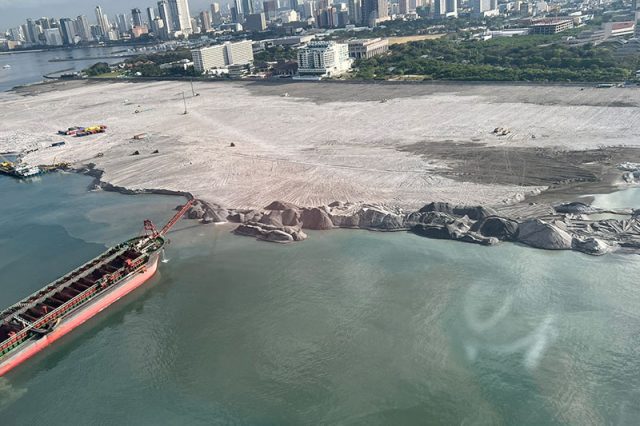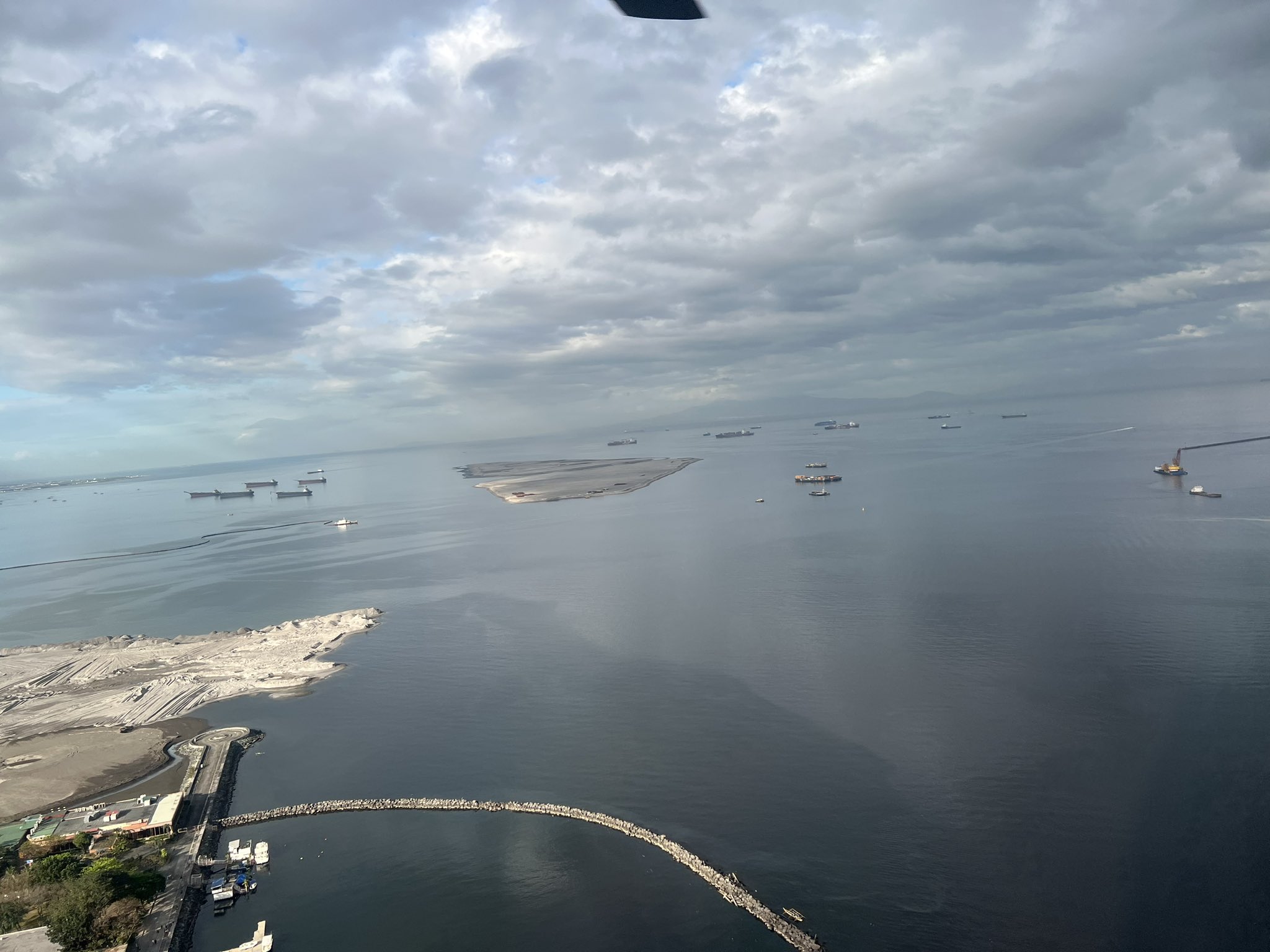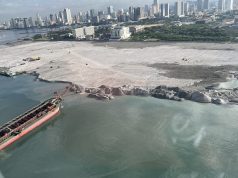
Discussions about reclamation projects on Manila Bay surfaced anew after a lawmaker shared pictures of aerial views of the natural harbor on Thursday.
Sen. JV Ejercito on February 16 posted such pictures on Twitter with the following caption:
“Soon, we will not be able to see the famous sunset at Manila Bay from Roxas Boulevard. Wala na rin wedding by the sea sa Coconut Palace at Sofitel sa ngayon. Simple things we will miss…”
Coconut Palace is a government building located at the Cultural Center of the Philippines which used to be the office of former vice president Jejomar Binay.
Sofitel, meanwhile, is a five-star luxury hotel usually booked by the public for weddings and other formal occasions.
Both are in close proximity to Manila Bay, with the hotel especially known to boast of its previously unobstructed “stunning panoramic” view from its poolside and room balconies.



Other Filipinos also shared their own pictures on the replies thread of Ejercito’s tweet.
“OMG, I was at Sofitel today, kind of an eyesore at the moment, but I hope they make it beautiful when [it’s] all said [and] done,” a Twitter user said.
OMG I was at Sofitel today, kind of an eyesore at the moment, but i hope they make it beautiful when its all said & done. pic.twitter.com/FYLXfiypuA
— Mark (@bowb4mark) February 16, 2023
“I don’t even know how is this allowed. We don’t need more buildings! We need more open spaces to enjoy Manila!” another online user wrote.
Last month, views of Manila Bay amid the reclamation were similarly discussed on the platform.
“This is Sofitel and the view of Manila Bay now. This is just sad,” market surveillance analyst John Paul Tanyag wrote, adding a picture taken from the Skyscraper City website.
This is Sofitel and the view of Manila Bay now. This is just sad.
(Photo from https://t.co/T5CwL8LDHR) pic.twitter.com/DTgxG5pLBT
— JP 🔊 (@dumidyeypee) January 25, 2023
Tanyag also shared another photo of the reclamation project in the replies thread.
Another photo https://t.co/BINC2btosv pic.twitter.com/vy6uWEzSiK
— JP 🔊 (@dumidyeypee) January 26, 2023
A Twitter user claimed of visiting the hotel last month and seeing “sands” instead of views of the natural harbor.
“A closer look. We visited last Saturday, excited pa naman ako to show my niece kaso puro buhangin na pala :(,” she wrote in response to Tanyag’s post.
A closer look. We visited last Saturday, excited pa naman ako to show my niece kaso puro buhangin na pala 🙁 pic.twitter.com/B1fteSgrea
— Steph, RPh (@StephCollado) January 25, 2023
A different online user who saw Tanyag’s tweet shared screengrabs of Sofitel’s views as of December 2022.
I want to know who's responsible for this perversion.
Screenshots taken from this video:https://t.co/An8kt1kp12 pic.twitter.com/DWZ80LZKyS
— The Wasted Wanderer (@_wastedwanderer) January 26, 2023
The screengrabs were from a video posted by a YouTube channel called “8 Miles from Home,” a “family-friendly” vlog of a British family in the Philippines.
“We are checking out of the Sofitel at Manila Bay today, since we arrived at the hotel, the ships have been dumping material into the sea and we’ve since found out that there is a huge reclamation project happening,” part of the video’s description reads.
“There will be a new smart city and airport built out in front of the Sofitel Manila, completely removing the seaside location. Does this mean that Manila Bay will be ruined now?” it added.
“It certainly doesn’t look good from an environmental and visual perspective, but we can only hope that the effect will be positive when it is all completed,” the description further said.
Last September, environmental concerns about the reclamations were raised after Tanyag shared screengrabs of Facebook posts noticing the change in Manila Bay.
READ: Reclamation projects in NCR spur concerns on vulnerability to rising sea levels anew
Two months later, a similar topic was brought up in the Senate during a budget deliberation for the Department of Environment and Natural Resources.
The DENR said that there were 19 reclamation projects in Manila Bay as of November.
Sen. Cynthia Villar previously lashed out at the office for granting environment compliance certificates to these projects, saying that areas such as Las Piñas, her home city, will become flooded due to the massive landscape change.
She said that the reclamation would close off the flow of water from four rivers in Las Piñas and Cavite, which would cause flooding.
“Ako, sinabi ko sa inyo, huwag niyong pakikialaman ‘yung aming daan doon. We have four rivers going out of that bay. Where will the river go, the water of the river go? Sinasabi ko na palagi sa inyo ‘yan, ayaw kayo tumigil. Hindi ako pumayag diyan,” Villar said.
The senator, a member of the Aguilar-Villar clan that has run Las Piñas for decades, lamented how she has supposedly spent 10 years of her life cleaning up “her river.”
“It took me 10 years to clean my river so there will be no flooding, tapos sasarhan niyo iyong daan ng river ko?” she said. “I cleaned 30 kilometers of river, ba’t hindi sasama loob ko?”
Manila Bay is a 199,400-hectare body of water in Luzon with a coastline running from the areas of Cavite, Parañaque, Pasay, Manila, Malabon, Navotas, Bulacan, Pampanga, and Bataan.
Oceana Philippines, a non-government organization working to protect the country’s oceans and other bodies of water, said that the Philippines’ fisheries industry accounts for 67% of the bay’s total value.
Land reclamation is an urban expansion strategy that expands territories for residential, commercial, and industrial purposes. It seeks to create economic opportunities through massive capital investment and by generating jobs for the market.
However, experts have been raising the alarm over its effects on coastal marine ecosystems and the environment, especially since the country is vulnerable to the impacts of climate change.









